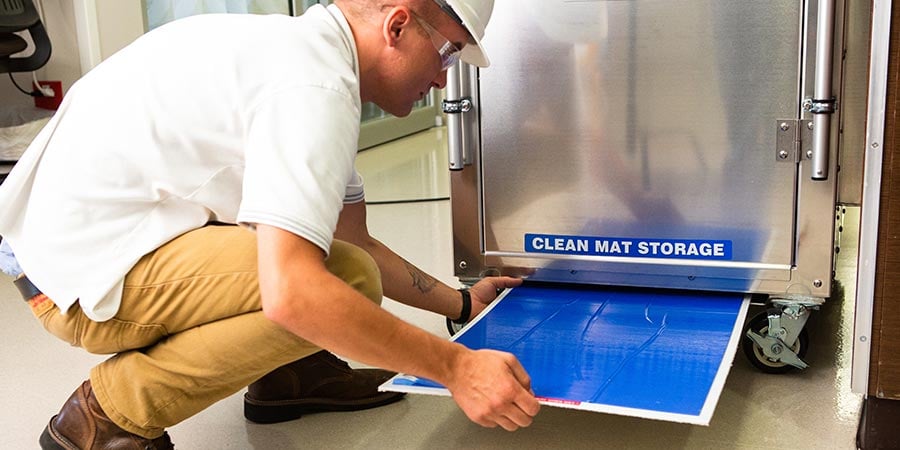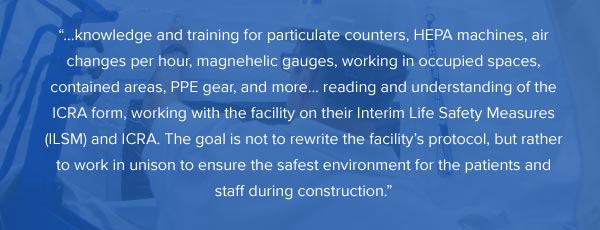Share this
What Contractors Need To Know About ICRA In A Healthcare Setting
by HEPACART on Jun 23, 2021
It's critical that design, construction, and risk mitigation be guided by an infection control risk assessment (ICRA).
Healthcare construction has been affected by the COVID-19 pandemic in many ways, with hospital budgets shrinking due to large declines in elective surgeries even as spending increased for coronavirus-related initiatives, equipment, and supplies. A trend seems to be emerging to build smaller facilities as well.
However, the fundamentals of preventing healthcare-associated infections (HAIs) have not changed. It's still critical that design, construction, and risk mitigation be guided by an infection control risk assessment (ICRA). If highly dust-producing construction is done in proximity to high-risk patients, the most stringent class IV protocols must be followed. And it's doubly important that hospital construction workers be trained to respond quickly to unexpected problems that crop up during hospital renovation, always with the goal of protecting patients from exposure to airborne or waterborne pathogens.
Hospitals are subject to unannounced visits by the Joint Commission, which is responsible for inspecting and enforcing CDC regulations. A facility's eligibility for federally-funded programs such as Medicare and Medicaid can be threatened by violations, making it crucial that the client's ICRA team and the contractor collaborate from the very beginning.
There are many possible expensive and dangerous outcomes if they don't. For instance, if dust penetrates patient care areas because of lax dust containment measures, patients can develop fatal infections from mold exposure.
The ICRA Team
Typically an infection control officer heads the multidisciplinary project team responsible for performing the required infection control risk assessment. This should take place in the earliest phases of planning, using the ICRA matrix. If the hospital doesn't reach out to the construction team, the contractor should make it a priority to contact them as soon as possible to provide input during the pre-risk assessment.
Project team members can include administrators, clinicians, infection preventionists, architects, IT specialists, facility managers, equipment users, support staff, patient advocates, occupational health specialists, and others. The team will be doing such things as:
- Reviewing construction locations
- Making recommendations on routing to and from patient care areas
- Analyzing airflow patterns
- Determining barrier construction details
- Selecting equipment to generate negative air pressure within construction areas
The contractor's contributions to the project team will be extremely valuable since health care professionals with no background in construction may have trouble visualizing workflows and equipment locations from blueprints.
ICRA in Planning & Designing
In the planning and design phases of the project, the ICRA team should consider factors such as:
- Number and location of patient isolation rooms
- Air handling and ventilation needs in ORs, infection isolation rooms, and labs
- Water systems to limit Legionella sp. and other waterborne opportunistic pathogens
- Patient access and workflow
- Contaminant control through strategically located tracking mats and cleaning supplies

Beyond those fundamentals, the patient care environment must be considered. The experience of everyone who spends time in hospital is directly affected by key aspects of the physical environment, which in turn affect patient care outcomes, dignity, privacy, confidentiality, safety, and overall satisfaction. Even during construction, then, it is crucial to make the patient care environment a top priority.
ICRA in Construction
During construction, contractors know it's the hospital's schedules that are driving the bus. As part of the project team, the contractor will make adjustments such as avoiding vibration-creating tasks on days when physicians have scheduled eye surgery.
When utility shutdowns are required, they have been planned weeks in advance and are strictly managed and clearly communicated. Likewise, for shutdowns of mechanical systems, which must be done in close coordination with the facility manager.
Other ICRA considerations during construction include:
- Determination of specific protection levels for various construction tasks
- Protection of patients during unplanned outages
- Consideration of how emergencies affect traffic flow and movement of debris
Contractors should have procedures in place to track and respond to risks:
- Using daily checklists to ensure strict adherence to safety protocols
- Performing weekly reviews leading to plan adjustments and modifications
- Monitoring negative air pressure with instrumentation that provides both continual visual measuring and alarms
ICRA in Risk Mitigation
Patient placement and relocation is a top issue when it comes to keeping patients safe.

Other considerations include:
- Temporary provisions for modification of HVAC and water supply systems
- Measures to protect patients and staff during demolition
- Standards for barriers and equipment designed to remove airborne contaminants
- Training of hospital staff and construction personnel (more on that below)
Throughout the project, the ICRA team must perform inspections to monitor the effectiveness of infection control measures. There must be written procedures for an emergency suspension of work, should that become necessary to protect patients, staff, and workers. Each party's responsibilities should be outlined, so the contractor's duties, the hospital, consultant, designer, owner, or other involved party are clear.
ICRA Training
You are undoubtedly aware that there is plenty of training for contractors on patient safety in hospital construction, offered by carpenter's unions and other entities (see resources, below).
As just one example, the Chicago regional council of the national carpenter's union provides training in the following areas:

Also, the American Society for Healthcare Engineering offers a broad set of professional courses for contractors focusing on patient safety and the unique challenges of healthcare construction. Many other sources of training are listed by the Premiere Safety Institute here.
Conclusion
Finally, we have a handy, one-page ICRA Process Checklist for you to download. Think of it as a vastly simplified version of this blog post, covering how to apply ICRA in design, construction, and infection control risk mitigation. For a more detailed resource, download our ICRA Precautions Matrix for Construction & Renovation.
For more information, explore these helpful construction and ICRA-related articles.
ICRA:
- Construction Contractors: 5 Essential Things to Consider About Healthcare Construction
- 5 Healthcare Construction Best Practices for Occupied Healthcare Facilities
- ICRA Class IV Infection Control Solutions for Healthcare Construction
- ICRA Construction Trades Best Practices Awareness Training (video)
- ICRA Training Module 1 (video)
- ICRA Matrix (PDF)
- Infection Control Risk Assessment Matrix of Precautions for Construction & Renovation
Organizations offering resources to help prevent infection during construction:
- American Society of Healthcare Engineers
- Association for Professionals in Infection Control and Epidemiology
- Chicago Regional Council of Carpenters Apprentice and Training Program
More related articles:

